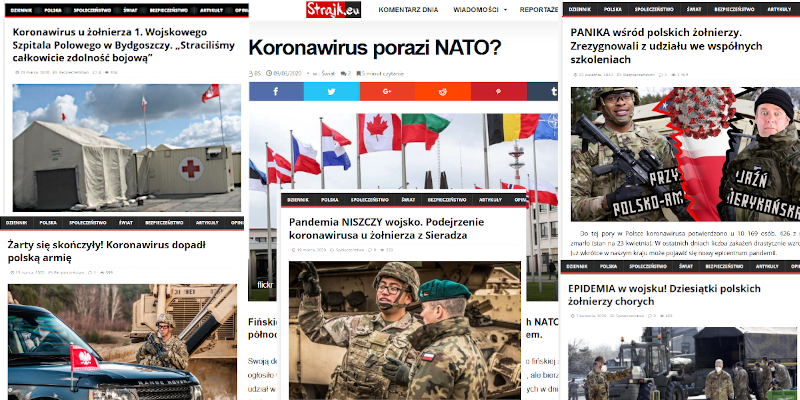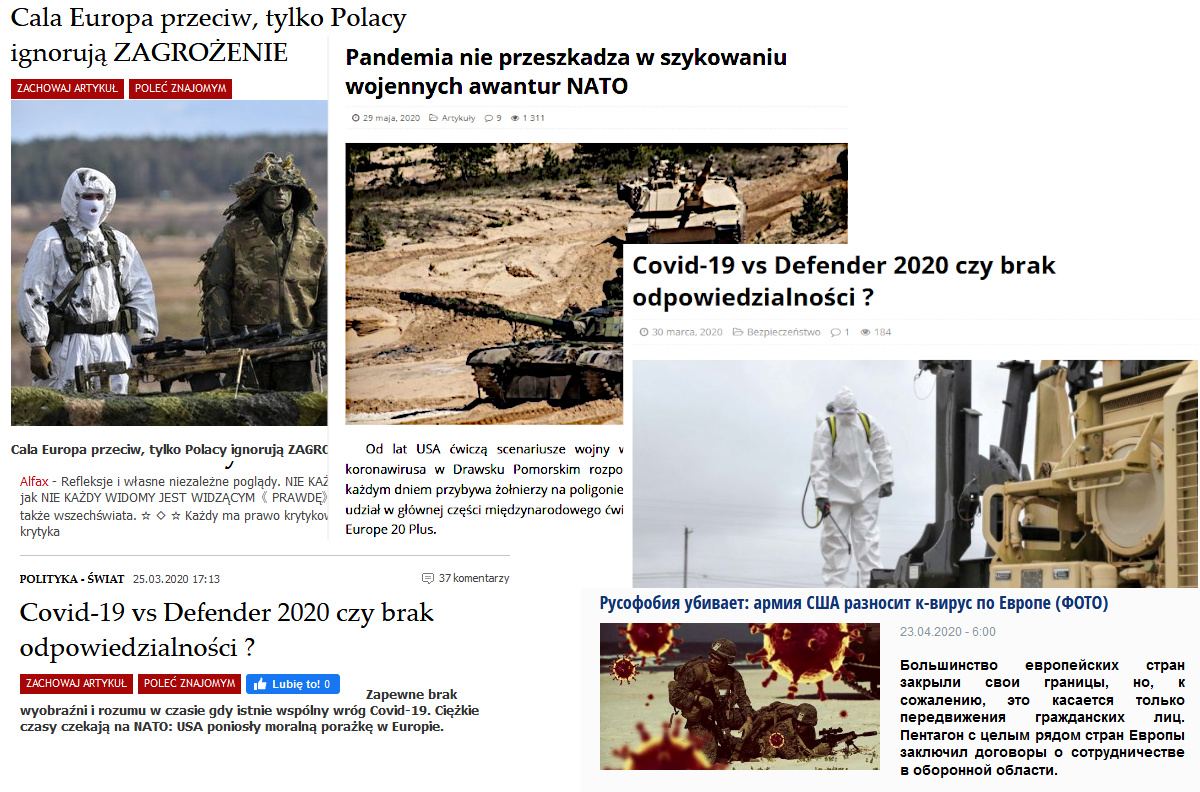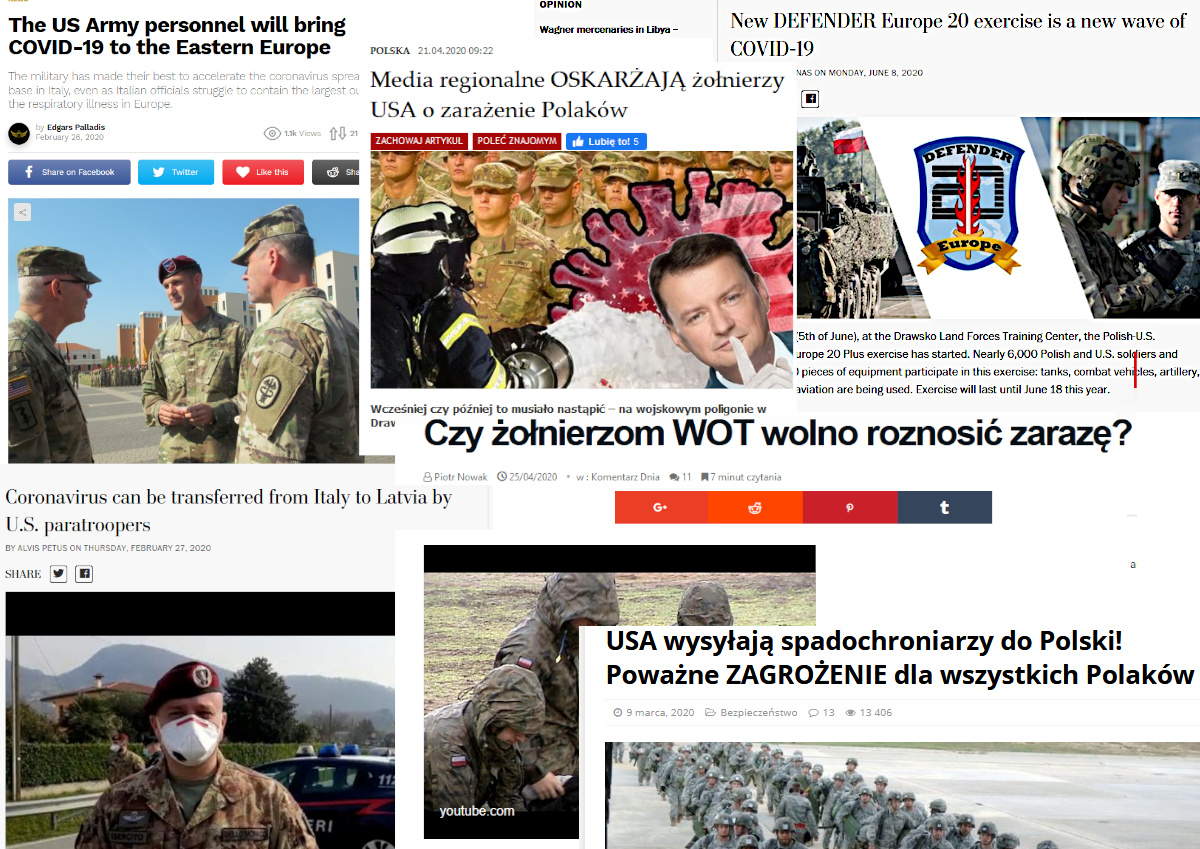The military cooperation between Poland and the U.S., the activities of the Polish army, and their military exercises are under constant attack by websites notorious for spreading the Russian disinformation. In recent weeks, the narratives pushed by these media outlets have repeatedly exploited the issue of the COVID-19 pandemic with the aim to hit Poland and to further anti-Polish agenda.
PATTERN No. 1
Much of the content posted to the websites actively engaged in information warfare efforts against Poland have exploited the fears of the pandemic to suggest that the Polish army was decimated by the coronavirus. According to the narratives pushed by Russia, the Polish Armed Forces were paralyzed, incapable of fulfilling their duties, and the soldiers were overwhelmed by panic. The articles in question also featured claims that the alleged rise in coronavirus cases among the servicemen was a systemic problem for the whole army. It was also suggested that the pandemic had paralyzed both the armed forces as a whole, and individual Polish soldiers.

The aforementioned narratives aimed to:
- Undermine the image of the Polish Armed Forces.
- Question the army’s capability to defend Poland.
- Sow information chaos regarding the issue of the armed forces.
- Sow panic among the military.
- Undermine the morale of the Polish soldiers.
- Breed mistrust of U.S. troops deployed to Poland and the Polish troops.
PATTERN No. 2
News websites that amplify Russian propaganda claims have weaponized the #COVID19 narratives to portray the Polish army and the Allied forces as a threat to the Poles. They suggested that the Allied military presence in Poland posed a major threat to citizens.
More specifically, the army was depicted as a source of the outbreak and an environment where the coronavirus could spread easily. The following narratives were pushed: amid the pandemic, frequent interaction between the soldiers and the local civilians could bring harm to the whole of Polish society. Russian propaganda attempted to breed mistrust of both the Polish Armed Forces and the Allied soldiers. Suggestions were made that the Poles would be threatened by the military presence of the Allies.
Similar hostile narratives were pushed against those units of the Polish Army that had been actively engaged in tackling the pandemic for weeks. One of the targets was the Territorial Defence Forces which have been under sustained disinformation attacks by Russia since the day they were established.
Pushing such manipulated information aimed to:
- Breed mistrust of the Polish Armed Forces.
- Create a negative image of Allied soldiers in the eyes of Poles.
- Strengthen tensions between Poland and the U.S.
- Sow information chaos regarding the Polish Armed Forces and Allies.
- Exploit the fears of #COVID19 among society.
- Undermine the morale of the Polish and American soldiers.
PATTERN No. 3
News websites that regularly push Russian propaganda have exploited the epidemic to label Poland and NATO as being irresponsible and accuse them of making decisions that could jeopardize the safety of Polish society.
Those outlets amplified narratives suggesting that the continuation by NATO of its military activity amid the pandemic was dangerous. The fact that the military exercises were held as the struggle to contain the virus continued served as evidence that the Alliance valued its provocative military activity against Russia more than the safety of Polish citizens.
At the same time, a narrative was pushed suggesting that while Russia posed no threat whatsoever to the West, NATO’s activity on the Eastern Flank was irrational and groundless. Multiple articles would go on to say that the holding by NATO of military drills despite the pandemic clearly showed that it was the Alliance that threatened world peace.

Amplifying such propagandized narratives aimed to:
- Question the reliability of NATO and its member states.
- Undermine the morale of the soldiers taking part in Defender Europe 20.
- Depict the West as being aggressive toward Russia.
- Accuse the Alliance of taking a provocative stance on Russia.
- Undermine the credibility of Poland on the international arena.
A characteristic feature of the Russian information warfare efforts against Poland is the design to exploit the current epidemic situation to denigrate Poland and NATO. By the way, Russia uses the #COVID19 pandemic on an ongoing basis to pursue its strategic goals.
This short analysis of the recently reported examples of Russian and pro-Russian propaganda clearly shows that the military policy and the activity of the armed forces remain in the focus of the Russian information warfare activity.
Stanisław Żaryn is the Spokesperson of Poland’s Minister-Special Services Coordinator. Common Crisis is a CEPA analytical series on the implications of COVID-19 for the transatlantic relationship. All opinions are those of the author and do not necessarily represent the position or views of the institutions they represent or the Center for European Policy Analysis.
Common Crisis is a CEPA analytical series on the implications of COVID-19 for the transatlantic relationship. All opinions are those of the author and do not necessarily represent the position or views of the institutions they represent or the Center for European Policy Analysis.




